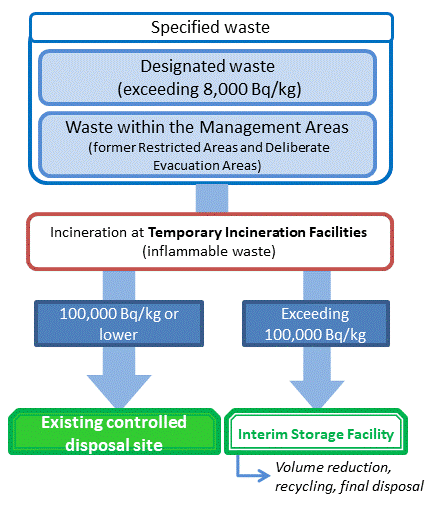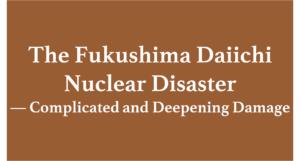4. Deepening Confusion over the Handling of Offsite Waste Derived from the Fukushima Accident
![]() Double standard with conventional nuclear waste
Double standard with conventional nuclear waste
The fate of waste contaminated by large amounts of radioactive material released from the Fukushima nuclear reactors remains confused. The biggest reason is that there is a double standard. The conventional radioactive clearance standard stipulated in the Act on the Regulation of Nuclear Source Material, Nuclear Fuel Material and Reactors is 100 becquerels per kilogram (Bq/kg). On the other hand, the newly stipulated standard in the Act on Special Measures concerning the handling of Environment Pollution by Radioactive Materials Discharged by the Nuclear Power Station Accident defines waste of 8000 Bq/kg or more as “designated waste,” allowing anything less than that to be disposed of in the same way as ordinary waste.
![]() Current Situation of “designated waste”
Current Situation of “designated waste”
The current Situation of “designated waste” (waste of 8000 Bq/kg or more and 100,000 Bq/kg or less) under the Act on Special Measures is given below.
As of the end of 2018, 218,700 tons of waste were designated and stored in 11 prefectures. This waste is limited to incinerated ash, agriculture and forestry waste (such as rice straw and compost), soil generated in water purification and sewage sludge, and does not refer to all radioactive waste substances.
The partial revision of the enforcement regulations of the Act on Special Measures in 2016 made it possible to cancel the designation of designated waste, this cancellation being carried out in three prefectures: Yamagata, Miyagi, and Chiba. No progress has been made in other prefectures.
Radioactive waste whose designation has been lifted is called “specified industrial waste” or “specified general waste” and is being incinerated or disposed of in the same way as regular waste (general and industrial waste).

Source: https://www.env.go.jp/en/chemi/rhm/basic-info/1st/09-03-03.html
![]() Recent trends in soil removed by decontamination work
Recent trends in soil removed by decontamination work
In 2018, there was a growing movement toward recycling removed soil (decontaminated soil) resulting from decontamination work or using it as landfill.
- Waste and removed soil in Fukushima Prefecture have been brought to and stored at temporary storage sites located near Fukushima Daiichi Nuclear power plant. The government has pledged to transport the waste and soil outside Fukushima Prefecture for final disposal after 30 years from the start of storage, that is, in 2045. The government (Ministry of the Environment) simply wants to reduce the total amount of waste, because finding final disposal sites outside Fukushima Prefecture is extremely difficult.
- The destinations of the designated waste and removed soil outside Fukushima Prefecture have not yet been decided, and discussions in each prefecture are showing no progress at all.
Why is there a policy to recycle soil contaminated with radioactive materials? An official of Ministry of the Environment answered this question by saying, “Soil is not waste, but resources (= valuable resources)“.
![]() Demonstration projects by the Ministry of the Environment (MoE) are underway
Demonstration projects by the Ministry of the Environment (MoE) are underway
The name “removed soil” is changed to “recycled materials” following sorting and treatment known as “recycled materials production.” MoE produced the “Technology Development Strategy for Volume Reduction and Recycling of Removed Soil in Interim Storage” and the “Concept on Safe Use of Removed Soil after Recycling” in 2016. Demonstration projects for recycling are being carried out in various places as follows.
| Fukushima Prefecture | Minamisoma City | Demonstration project for recycling and embankment tests were started at the end of 2016. |
| Nihonmatsu City | Since the beginning of 2018, the ministry has been planning a project to demonstrate the use of recycled materials for roadbed materials. In June 2018, the MoE announced its intention to cancel the project after local residents and civic groups held study meetings and signed a petition calling for the project to be canceled. However, in the “Review Committee on the Technological Development Strategy for Volume Reduction and Recycling of the Removed Soil in Interim Storage” in March 2019, it was reported that the plan was once again being considered, and thus it is hard to predict what will happen. |
|
| Iitate Village | Since the beginning of 2018, MoE has been planning a demonstration project using recycled soil for agricultural regeneration in the Nagadoro district of Iitate Village. The project is being promoted in a situation where it is difficult for the local community to raise their voices, because it is designated as part of a set of projects in a Specified Reconstruction and Revitalization Base. |
|
| Outside Fukushima Prefecture | A landfill demonstration project was conducted without proper consultation with local citizens in Nasu Town, Tochigi Prefecture and Tokai Village, Ibaraki Prefecture to use approximately 330,000 m3 of decontaminated soil from an intensive contamination survey area where decontamination was conducted. | |
Despite each demonstration project having the name “demonstration” attached to it, they each have aspects of actual implementation of the projects. MoE has already prepared ordinances or guidelines for the recycling and using as landfill soil resulting from decontamination both inside and outside Fukushima Prefecture, and is moving forward with plans to gradually implement recycling and landfill disposal in many locations. The series of nuclear waste policies, including the Act on Special Measures, aimed at putting radioactive contamination from the accident out of sight as if it had never existed, must be fundamentally reviewed.


